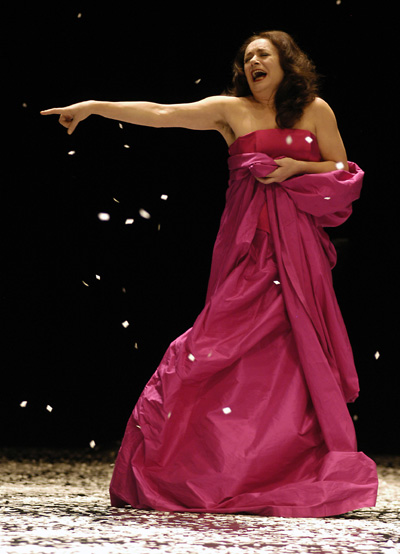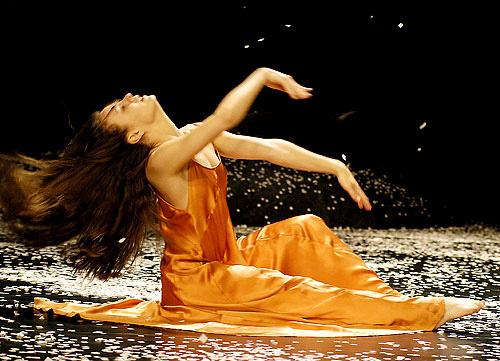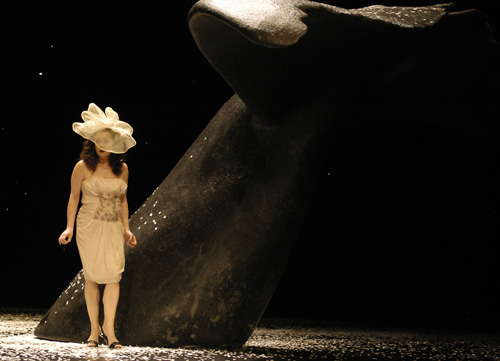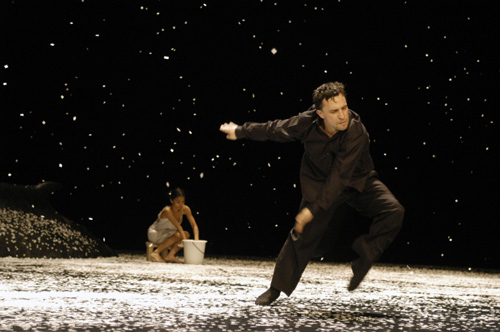|
Do you prefer Istanbul to Palermo or Lisbon? California to Brazil or Japan? For the last eleven years, Pina Bausch and her extraordinary Tanztheater Wuppertal have produced almost yearly "choreographic travelogues", spending "three weeks" abroad, gathering impressions like artistic anthropologists and building their observations into dance theater collages of operatic length. The method is always the same and so are the ingredients: the striking theatrical scenery by stage designer Peter Pabst, a flurry of skits and sexy sketches by the dancers (half of whom have been with Bausch for decades and never seem to age), song and speech numbers interspersed with solo dances, set to music from across the globe. Topics are the inexhaustible facets of human, in particular man-woman (mis)communication. Main props are chairs and tables, barely-there clingy slips and long gowns for the women who are barefoot or in very high heels; suits, casual attire or an occasional dress for the men.
Even with the different spices of varying locales, the Wuppertal menu offerings have come to taste pretty much the same. They are somewhat chaotic, tenderly absurd and funnily cruel cabaret-like creations, packed with ideas. Some ideas are brilliant, some fall flat or seem incomplete. On tour, texts are usually translated into the language of the host country, and the pronunciation of the dancers – given the gnarly English accents of the multi-ethnic group – is haphazard, losing punch/lines right and left. But the dancing and acting are always above par, in a class of their own. The impact of the show depends on how much viewers are able to connect with the material, find delight in the strong personalities of the dancers, or find themselves amused by the witty and self-conscious irony the far-traveling company professes about their foreign forays.
The latest in the series, Ten Chi (2004), is from Japan. Did Bausch choose this piece for her third-ever visit to Los Angeles and Berkeley because we are so close to Asia over here and thus more likely to understand the pieces of her Japanese puzzle? (Bausch herself was not present: she was accepting the 2007 Kyoto Prize for her oeuvre, in Japan.) I found her California-based creation Nur Du (Only You) from 1996 (inexplicably left out by the program notes) more engaging, perhaps because I was able to recognize the many ironic allusions in the details (for example, all the dancers running around with a water bottle attached to them). Nur Du was warmer, more communally playful, and the grand myths of Hollywood were delightfully exploited. Bausch's Japan is not a fuzzy place that welcomes you with a bear hug. Perhaps the colder, severe cultural climate got to them all: Ten Chi has a reserved quality of human isolation, reflected in the almost empty, deeply black stage, the many isolated solos, lack of group dancing or line formation that used to be the most exciting staple of Bausch's work.
Ten Chi begins promisingly: the strange metallic "dolmen" grave that seems to rise out of the darkness reveals itself as the huge tail fin of a whale. On the opposite site of the stage, the back and tail of a second whale emerge to mark the space. In the center, the shimmering figure of a small woman (Ditta Miranda Jasjfi) with dark cascading hair and a long silk gown dances in fierce concentration, bathed by a narrow flood of light from above. My association went to a modern Geisha dancing an "ode to Asian moonlight" with seductive hip rotations and hands aflutter like fans. A very tall, burly dancer steps up behind her, sticks one hand down her chest into her dress, his other hand lifts the seam of the dress from behind and probes upwards – and in the next moment she is held horizontally by his invisible grip, and now, like in a strange act of Noh theater, she is slowly swimming around the whale, arms and legs paddling peacefully...
It's one of these breathtaking moments when after thirty-some years of radical invention by Bausch's Tanztheater, one gasps again over something daring, something never before seen or felt. Are we diving into the unconscious of a water-born nation that won't leave its whale neighbors in peace? Forget it, there is of course never a clear, consistent "meaning" or even mood to Bausch's creations. Slapstick is next. The clown-like Nazareth Panadero enters in a huge taffeta dress, pursued by a young suitor, and tears bits of the dress off for him, shrieking with sexual excitement. The chanteuse/diseuse Mechthild Grossmann with her smoky baritone voice, wrapped into another baroque dress contraption, launches into a Sprechgesang fawning over all things Japanese: "Kimono!" she begins, ecstatic. "Ki...mo...no!" Then, spitting out harsh consonants in rapid-fire warrior speech, she goes on something like: "Ki ku tsi tus ma ka tu..." before again purring "Ki-mo-no!" Next, "Chop sticks" gets the same spitting and fawning treatment and the audience warms up considerably. Mount Fuji – Samourai – Geisha – Harakiri -- Bonzai... one Western klischee after another is voraciously eaten up by Grossmann until with "Sushi" she has the audience in stitches.
 |
The same degree of ironic distancing from tourism is maintained throughout the piece. Needless to say, no geisha appears, but in-between numerous scenes that have nothing to do with Japan, some calligraphy is being painted on a woman's naked back, a Western man is ceremonially undressed and dressed again by a Japanese man, a young colored man gently suffers being "dressed up" in ancient-Japanese garb by a Japanese girl, being made gentle fun of and having his picture taken. All of it is accompanied by gentle Western or Japanese music with only a gentle beat. A blond glamour girl does a lap dance on a man, facing the audience. An older male dancer (Dominique Mercy) does a melancholy solo in a black velvet dress. A Japanese girl "attacks" a big Western guy by running up to him from behind, leaping up at him and shooting a flashlight picture of his face. When he looks around, she is all apologetic smiles and bows... and there she goes again.
In one of Bausch's famous escalating scenes of repetition, a woman is trying to say good-bye in the Japanese way. A doe-like dancer (Helena Pikon), comes to the footlights with a backpack, " Sorry, excuse me, please, but we have to go..." She bows and smiles and walks away around the whale, only to be called back to the front where she must announce her departure again, and again, each time with more bowing politeness and twisted regret -- until she has convinced us that the idea of leaving has been not hers but ours.
Funnier still, a dancer in a white slip (Aida Vainieri), her thick mane of curls thrown forward to hide her face, stomps in on heavy high heels, chained by the neck like a beast. To the sounds of a martial arts fight, a throaty, brutal grunt, "Doo-shahhh!!", followed by thumps and thuds of bodies being thrown and smashed and pummeled, she throws and kicks and pummels a big white pillow with her blood-red stilettos. She does this in hilarious, exact synchronicity. Then this mad Godzilla drags herself to a chair by a table, plumps down onto the pillow (bloody squishy sounds, the audience squeal) and finally lifts her face out of her hair: the prettiest milk-chocolate-skinned woman is sitting at the table, smiling at the man who sits opposite her. She gives him a hungry look and, with one grip, pulls him with the entire table cloth over into her lap.

While the play with (or against) klischees goes on it has begun to snow. The snow continues through the break up to the very end. In one of the highlights of dancing, the tiny Ditta Miranda Jasjfi becomes a little girl exuberantly leaping, whirling, running, bathing her hair in the snow. Her joy and spontaneity are so unlikely in the context of the show that I suspected a double play: this was perhaps supposed to be an ad on Japanese TV selling us the glorious future of Japan. A moment later, a Japanese governess gently tries to teach the girl feminine restraint, to no avail. Later a kitschy song goes, "Falling like a silent petal, there will be no blossom on the tree..." During the song, Julie Shenanhan in a golden sheath performs an interesting solo that lifts the abstract dance into an archetypal realm. Always the platinum glamour girl, her languorous and suddenly edgy twists and turns and sexy, undulating and suddenly pointed arms transform her into a fascinating three-minute Goddess of Unfulfillable Longing.

By contrast, an apparent non-Goddess is posted at the whale tail fin as if under a street lamp. In an outrageous frou-frou hat that makes her look like an Easter egg , Mechthild Grossmann is waiting for men and accosting them in a rather unorthodox fashion: "They have discovered a new star up there..." (pointing skywards). Not too surprisingly, the men won't stop to listen to her going on about the discovery, and she finally concludes: "They have discovered a new star up there but I didn't notice that it made more light down here."
Not much light down here – is that the melancholy message of the black box of Ten Chi with its consoling confetti glimmer?
Ten Chi is a typical Bausch collage and as such, the piece is too complex and contradictory to reveal itself in one viewing. Bausch, "the uncrowned empress of modern dance" (Newsweek) is notorious for refusing to give even a hint of what she had in mind. But does she know herself? At opening night, she never feels ready and usually does not yet know how to sum up the pieces of the puzzle by giving them a name, a title. She has repeated many times that if she would tell what she sees she would deprive everybody else of their own vision. This is only fair. It puts the audience in the same shoes the dancers are in: taking away impressions and insights as fleeting and incomplete, even incoherent perhaps, in one night's performance as the company did in three weeks, for example in Japan.
My impression: the piece is once again too long, dragging on, filled with two many bit-pieces of déjà vu (a woman in transparent lace sits on a chair, a man sees her and goes down into eager push-ups in front of her; a man takes the seam of a woman's long white dress and stuffs it into his shirt front like a bib, etc.). The solos suffer from their repetitiveness in style – there is always a similar bend toward Pina Bausch's own past style of dancing: a very feminine Ausdruckstanz grounded in spiraling arm and torso movements (easily studied on YouTube in the excerpts from her sensational 1978 Café Müller). Her male dancers seem held back by this style, even if they throw in elements of hip-hop, martial arts or Salsa here and there. Such excellent dancers – I wish they would push the envelope and get more of an edge. It is already a relief to see an entirely new body type among the young male dancers who are all small and short-legged: Pascal Merighi is a very tall, burly guy, sort of a Gérard Dépardieu of modern dance. His long limbs can cross the entire stage in three hip-hop flips, promising a refreshing fierceness if not violence -- if he got permission...

Of course, the violence that once was the trademark of the Empress is long gone. Bausch used to excel at unleashing electrical storms of male and female energy in her dancers, men and women throwing each other literally against the walls in their desperate need to get close or get away from each other. And even though it has been touching, over the last decade or so, to see the radical choreographer age and mature into her own more mellow, forgiving "classicism", something is amiss. Whether in Japan or Germany, living in today's world is a painful exercise that ought to find more expression in the young dancers' contribution to the work – some notion that human beings, among the whales on stage, are a dangerous species.

Cover and text photos - Bettina Stoess
Pina Bausch Tanztheater Wuppertal
performs Ten Chi at Berkeley Cal
|
|

